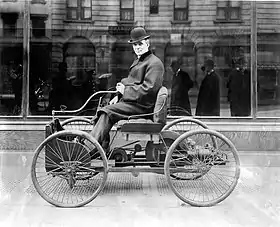| Ford Quadricycle | |
|---|---|
 | |
| Overview | |
| Manufacturer | Henry Ford |
| Also called | The horseless carriage |
| Production | 1896–1901 Ford sold his first Quadricycle for $200 in 1896 to Charles Ainsley. He later built two more Quadricycles: one in 1899, and another in 1901. He eventually bought his first one back for $60.[1] (according to Ford Museum records) |
| Designer | Henry Ford |
| Body and chassis | |
| Body style | 2-seat roadster |
| Powertrain | |
| Engine | 2-cylinder |
| Transmission | 2-speed (no reverse)[2] |
| Dimensions | |
| Wheelbase | 49 in (1,200 mm) |
| Curb weight | 500 lb (230 kg)[2] |
| Chronology | |
| Successor | Ford Model A (1903–04) |
The Ford Quadricycle was the first vehicle developed by Henry Ford. Ford's first car was a simple frame with a gas-powered engine and four bicycle wheels mounted on it.[3]
The earliest cars were hand built, one by one, and very expensive. The peculiar machines were seen as toys for the rich.[3] In the 1890s, the "horseless carriage" was a relatively new idea, with no one having a fixed, universal idea of what a car should look like or how it should work. Most of the first car builders were inventors, rather than businessmen, working with their imaginations and the parts they had on hand.[3] Thus, the invention of the Quadricycle marks an important innovation as a proto-automobile that would lay the foundation for the future, with more practical designs to follow.
On June 4, 1896, in a tiny workshop behind his home on 58 Bagley Avenue, Detroit,[2][4] where the Michigan Building now stands, Ford put the finishing touches on his pure ethanol-powered motor. After more than two years of experimentation, Ford, at the age of 32, had completed his first experimental automobile. He dubbed his creation the "Quadricycle", so named because it ran on four bicycle tires, and because of the means through which the engine drove the back wheels.[5] The success of the little vehicle led to the founding of the Detroit Automobile Company in 1899, followed by the Henry Ford Company in 1901 and then later the Ford Motor Company in 1903.[6]
The two cylinder engine could produce 4 horsepower.[7] The Quadricycle was driven by a chain. The transmission had only two gears (first for up to 10 mph (16 km/h), 2nd for up to 20 mph (32 km/h)), but did not have a reverse gear. The tiller-steered machine had wire wheels and a 3 US gal (11 L) fuel tank under the seat.[2] Ford test drove it on June 4, 1896, after various test drives, achieving a top speed of 20 mph (32 km/h).[2] Ford would later go on to found the Ford Motor Company and become one of the world's richest men.[3]
The original Quadricycle resides at The Henry Ford Museum in Dearborn, Michigan.
See also
References
- ↑ Herndon, Ford: An Unconventional Biography of the Men and Their Times, (New York: Weybright & Talley, 1969), p. 62; also Flammang et al., Ford Chronicle, (Publications International, 1992), p. 9 (as cited in Brinkley, David, Wheels for the World: Henry Ford, His Company, and a Century of Progress, (New York: Penguin Group, 2003), p. 23
- 1 2 3 4 5 Clymer, Floyd. Treasury of Early American Automobiles, 1877–1925 (New York: Bonanza Books, 1950), p. 58.
- 1 2 3 4 Doeden, Matt (2007). Crazy Cars. Lerner Publications. ISBN 978-0-8225-6565-9.
- ↑ "Henry Ford Story Timeline - Henry Ford Heritage Association". hfha.org. Retrieved 2016-11-27.
- ↑ Brinkley, David, Wheels for the World: Henry Ford, His Company, and a Century of Progress, (New York: Penguin Group, 2003), p. 22
- ↑ The Showroom of Automotive History: 1896 Quadricycle Archived 2010-06-15 at the Wayback Machine
- ↑ 1896 Ford Quadricycle RemarkableCars.com